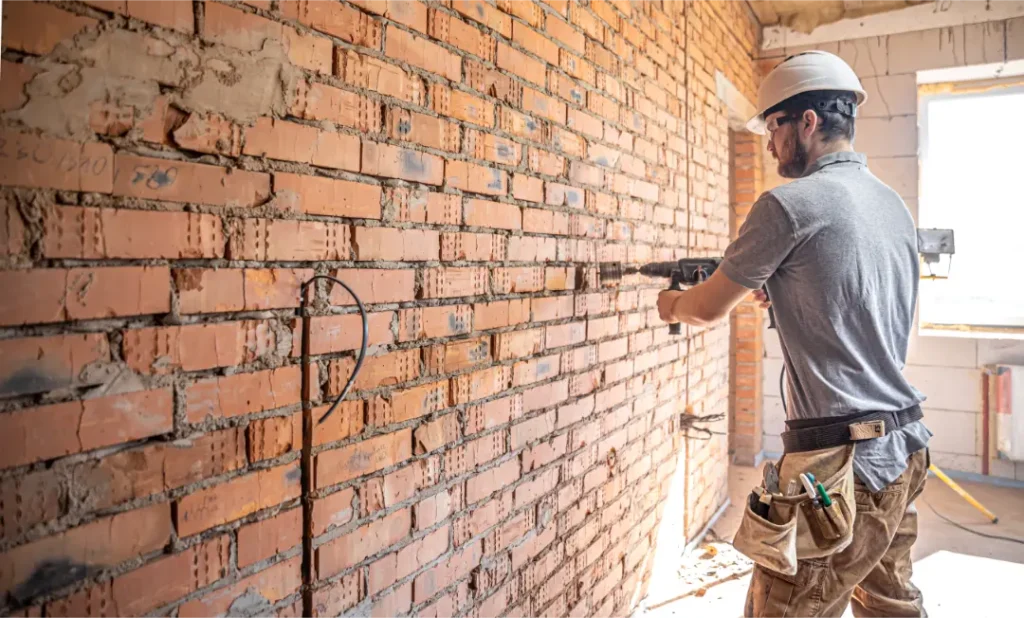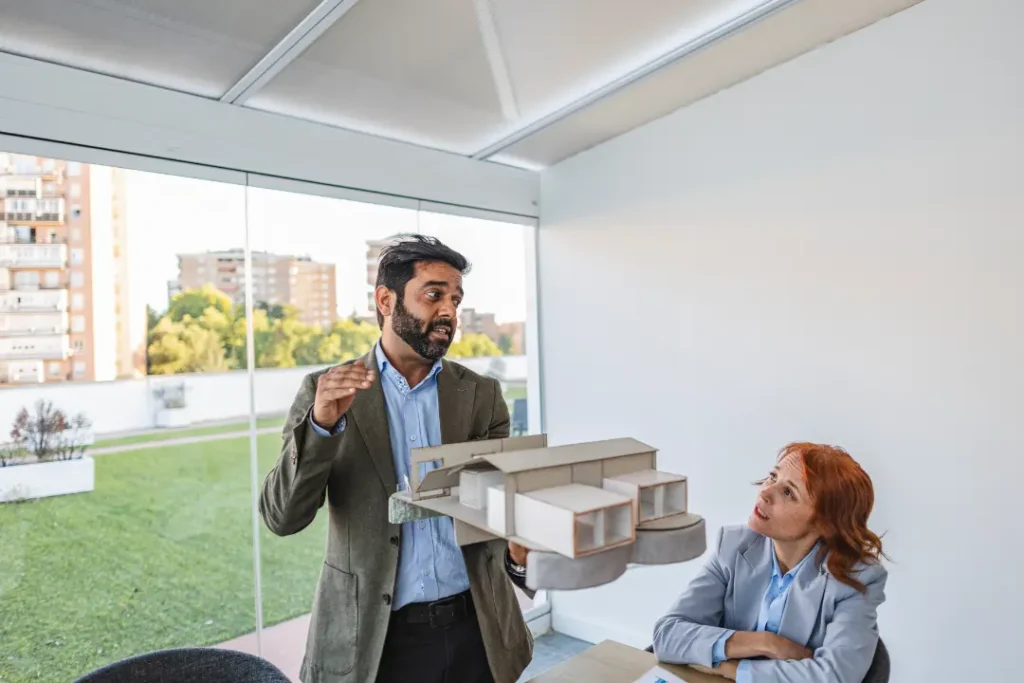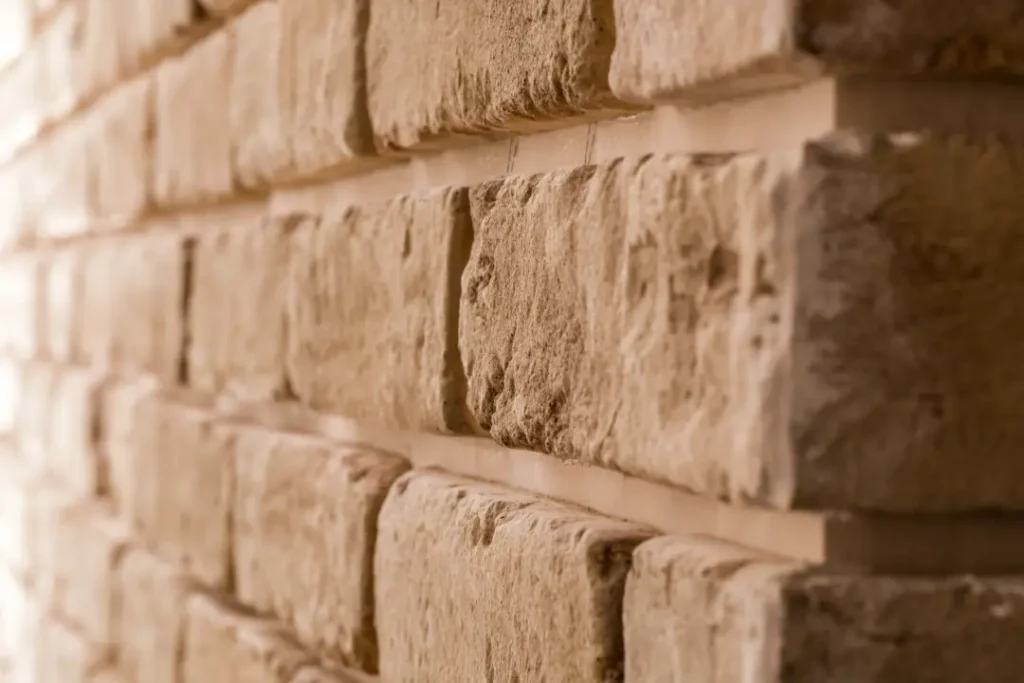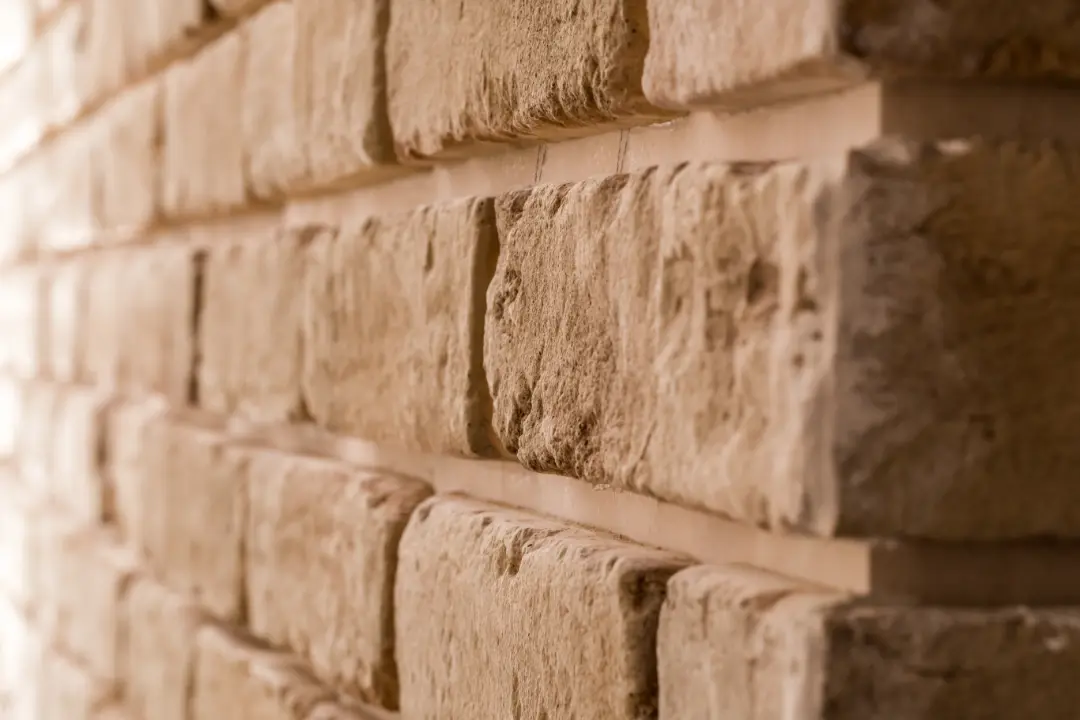If you’re trying to decide whether to repoint or render, this article will guide you to the best option for your home.
We will compare these methods based on cost, durability, and visual appeal, so that you can make the best choice for maintaining your property.
Key Takeaways
- Repointing strengthens brick walls by replacing damaged mortar, improving both stability and aesthetics.
- Rendering offers a protective layer over masonry, enhancing curb appeal while addressing weather damage, but it can be more costly.
- Both methods have their benefits; repointing generally requires less maintenance and has a longer lifespan than rendering.
Understanding Repointing
Repointing, often overlooked, is a cornerstone of maintaining the beauty and stability of brick structures. Have you walked past an old house with damp cracks in the crumbling mortar joints? The sight is not just an eyesore but also a precursor to potential structural issues.
What is repointing?
Repointing is the meticulous process of removing mortar and replacing damaged mortar joints in brickwork. It involves carefully raking out the old mortar and applying new mortar to restore the wall’s integrity, which can be replaced.
The quality of repointing work largely depends on the professionals’ expertise. So, it is always best to hire seasoned repointing experts to ensure the job is done correctly, prevent future problems, and maintain structural integrity.

What Are the Benefits of Repointing?
The benefits of repointing extend beyond mere aesthetics and include:
- Using lime mortar in repointing allows moisture to escape, effectively addressing dampness issues.
- It significantly strengthens the joint between bricks.
- It enhances the overall structural stability of your property.
Additionally, repointing can greatly improve the visual quality of brick structures, preserving their historical character and making them look well-maintained and attractive, which can force a positive impression on viewers.
When Should You Repoint?
Knowing when to repoint is crucial for the longevity of your brickwork. General indications for repointing include:
- Crumbling mortar
- Water penetration
- Loose bricks
So, if you are seeing visible wear in mortar joints, it clearly indicates the need for repointing to prevent further damage. Ignoring these signs can lead to more severe structural damage and costly repairs in the future.
What is rendering?
Rendering involves applying a mix to the surface of walls or buildings to enhance appearance and protect against weather damage. This typically involves mixing materials like cement and lime with water to seal moisture and applying the mixture using various techniques.
Rendering provides an alternative method for maintaining and enhancing your home’s exterior. While repointing focuses on the mortar joints in brickwork, rendering involves applying a material layer over masonry to protect and beautify the underlying structure.
Rendering is an excellent option for covering deteriorating brickwork or achieving a sleek, modern look.
What Are the Benefits of Rendering
Rendering provides a host of benefits. Modern rendering materials resist cracking, enhancing durability and reducing maintenance. Certain materials, like silicone-based renders, enhance energy efficiency by effectively enhancing thermal performance and managing moisture.
Rendering also significantly boosts a building’s visual appeal, offering finishes from smooth and modern to rustic and traditional.

When Should You Render?
Rendering is especially useful for covering deteriorating brickwork or achieving a consistent appearance across exterior walls.
It’s also a great option for unifying the look of an extension with the main structure, preventing mould growth.
Rendering enhances property protection and offers a chance to modernise its appearance.
Comparing Costs: Repointing vs. Rendering
Repointing and rendering costs can vary widely depending on the condition of the brickwork, the type of materials used, and the complexity of the project.
Labour typically constitutes a significant portion of the expenses, with additional costs potentially arising from scaffolding for taller structures, removal of old materials, and preparation work.
The choice of render type also influences the overall cost, especially for more expensive, higher-end options. Prices are influenced by many factors, and it’s advisable to obtain detailed quotes tailored to your specific project requirements.
Durability and Maintenance
Both repointing and rendering provide long-term solutions, though with different maintenance needs. Repointing requires less frequent maintenance, making it a more durable long-term option.
Longevity of repointing
Properly done repointing can last from 20 to 50 years, depending on environmental factors and the quality of initial work.
However, regular inspections and minor repairs are needed every 10-20 years to ensure repointing longevity.
Longevity of rendering
Rendered surfaces generally offer a good lifespan, balancing aesthetic enhancement and structural integrity. Regular maintenance, including inspections and repairs, is also essential to ensure their longevity.
Aesthetic Considerations
Aesthetics are crucial in choosing between repointing and rendering. Both methods significantly influence your property’s visual appeal, aligning with your style preferences.
Visual appeal of repointing
Repointing greatly enhances a property’s visual appeal, making it look well-maintained and attractive. The process highlights the intricate details of pointed brickwork, contributing to a more polished and charming facade.
Choosing the right mortar colour and type ensures a proper aesthetic match with the existing mortar brick.
Visual appeal of rendering
Rendering acts as both a protective layer and a decorative finish for whole-house homes.
It offers various textures and finishes, allowing homeowners to completely transform their property’s aesthetic outlook.
Environmental Impact
Environmental considerations are becoming increasingly important in home improvement projects. Both repointing and rendering offer eco-friendly options to help reduce your home’s carbon footprint.
Eco-friendliness of repointing
Repointing with lime mortar is sustainable and offers several benefits:
- Made from natural materials
- Has a lower ecological footprint compared to modern cement
- Its flexibility allows it to absorb moisture and prevent damage to the underlying brickwork
- Helps maintain the structural integrity and aesthetics of older buildings

Eco-friendliness of rendering
Rendering offers sustainability benefits through materials that improve energy efficiency and longevity. However, it’s important to consider the environmental impacts of rendering techniques, including the carbon footprint of different materials and their effects on local ecosystems.
How Poor Repointing Wastes Money and Destroys Brickwork
Many property owners make the costly mistake of choosing cheaper, cement-based repointing jobs, only to face cracking bricks, rising damp, and irreversible wall damage within a decade.
Unlike lime mortar, cement doesn’t flex or breathe with the wall. It traps moisture, pushing it into the brickwork, which leads to decay from the inside out. These repairs often end in needing brick replacements or full structural restorations, costing far more than a proper repointing job would have.
A one-time investment in professional repointing protects your property for generations.
Environ Property Services: The Gold Standard in London Brick Repointing
At Environ Property Services, brick repointing isn’t just another building task but a skilled heritage service that protects your home for decades. We specialise in traditional lime mortar repointing, hand-mixed on-site to suit the specific composition of your property’s original mortar.
Our approach is meticulous, beginning with a thorough assessment of your brickwork. We carefully rake out deteriorated joints by hand to prevent damaging the surrounding bricks. Next, we apply a lime mortar that is chosen for its durability, flexibility, and breathability—essential qualities for maintaining the health of both historic and modern masonry.
Led by director Terry Clark, a member of The Society for the Protection of Ancient Buildings (SPAB), our team is trained in traditional conservation methods that many modern contractors overlook. That means no damaging cement mixes, no rushed finishes, and no “one-size-fits-all” shortcuts.
Whether we are restoring a Georgian terrace in Kensington or protecting a Victorian façade in Clapham, we honour the original character of your building while reinforcing its future strength. Our repointing is sure to last over 60 years, with craftsmanship designed to prevent damp, cracking, and costly structural failure.
Call us today to receive a detailed quote.
Frequently Asked Questions
What is repointing?
Repointing is basically fixing up your brickwork by taking out the old, damaged mortar and replacing it to keep your walls strong and looking good. It’s essential for maintaining the integrity of your structure!
When should I consider repointing my brickwork?
If you see crumbling mortar, water penetration, or loose bricks, it’s time to think about repointing your brickwork. Keeping an eye on these signs will help maintain the integrity of your structure.
What are the benefits of rendering a property?
Rendering a property boosts its durability and visual appeal while improving energy efficiency, giving you a variety of aesthetic choices to enhance its overall look. It’s a smart investment for both style and performance!
How long does repointing typically last?
Repointing done right can last more than a century with just a little maintenance. So, if you want it to last, be sure to use quality materials and techniques!
Why is professional consultation important for repointing and rendering projects?
Getting professional consultation for repointing and rendering projects is crucial because it guarantees high-quality results and customised solutions, preventing costly mistakes down the line. Trusting experts can make all the difference in your project’s success!
Conclusion
Both repointing and rendering offer unique benefits that can enhance your home’s structural integrity and visual appeal. Repointing is ideal for preserving the character and stability of brickwork, while rendering provides a modern, protective finish.
Understanding the costs, durability, maintenance, and environmental impact of each option will help you make the best decision for your property. Whether you choose repointing or rendering, professional consultation is key to achieving the best results.

